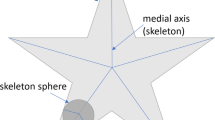Abstract
The Medial Axis Transform (MAT) (or skeleton transform) is one of the most studied shape representation techniques with established advantages for general 2D shape recognition. Embedding local boundary information in the skeleton, in particular, has been shown to improve 2D shape recognition capability to state of the art levels. In this paper we present a visual pathway for extracting an analogous to the MAT skeleton abstraction of shape that also contains local boundary curvature information. We refer to this structure with the term curvature-skeleton. The proposed architecture is inspired by the biological findings regarding the cortical neurons of the visual cortex and their special purpose Receptive Fields (RFs). Points of high curvature are initially identified and subsequently combined by means of a visual pathway that achieves an analogous to the MAT abstraction of shape but also embeds in the skeleton local curvature information of the shape’s boundary. We present experimental results illustrating that such an abstraction can improve the recognition capability of multi layered neural network classifiers.
Access this chapter
Tax calculation will be finalised at checkout
Purchases are for personal use only
Preview
Unable to display preview. Download preview PDF.
Similar content being viewed by others
References
Hubel, D.H., Wiesel, T.: Receptive fields and functional architecture of monkey striate cortex. J. Physiol. 195, 215–243 (1968)
Raftopoulos, K.A., Papadakis, N., Ntalianis, K.S.: Visual pathways for detection of landmark points. In: Kollias, S.D., Stafylopatis, A., Duch, W., Oja, E. (eds.) ICANN 2006. LNCS, vol. 4131, pp. 728–739. Springer, Heidelberg (2006)
Goodale, M.A., Meenan, J.P., Buelthoff, H.H., Nicolle, D.A., Murphy, K.J., Racicot, C.I.: Separate neural pathways for the visual analysis of object shape in perception and prehension. Current Biol. 4, 604–610 (1994)
Ungerleider, L.G., Courtney, S.M., Haxby, J.V.: A neural system for human visual working memory. Proc. Natl. Acad. Sci. USA 95, 883–890 (1998)
Dobbins, A., Zucker, S.W., Cynader, M.S.: Endstopped neurons in the visual cortex as a substrate for calculating curvature. Nature 329, 438–441 (1987)
Biederman, I.: Recognition-by-components: A theory of human image understanding. Psychological Review 94, 115–147 (1987)
Bookstein, F.L.: Landmark methods for forms without landmarks: morphometrics of group differences in outline shape. Med. Im. Anal. 1, 225–243 (1996)
Berretti, S., Bimbo, A.D., Pala, P.: Retrieval by shape similarity with perceptual distance and effective indexing. IEEE Trans on Multimedia 2, 225–239 (2000)
Mokharian, F.: A theory of multiscale, curvature-based shape representation for planar curves. IEEE Trans. Pattern Anal. Mach. Intell. 14, 789–805 (1992)
Dudek, G., Tsotsos, J.K.: Shape representation and recognition from multiscale curvature. Comput. Vis. Image Understand. 68, 170–189 (1997)
Super, B.J.: Fast correspondence-based system for shape-retrieval. Patt. Recog. Lett. 24, 217–225 (2004)
Blum, H.: A transformation for extracting new descriptors of shape. Models for the Perception of Speech and Visual Forms (1967)
Davis, L.: Two-dimensional shape representation. Academic Press, London (1986)
Sebastian, T.B., Klein, P.N., Kimia, B.B.: Recognition of shapes by editing their shock graphs. IEEE Transactions on PAMI 26, 550–571 (2004)
Aslan, C., Erdem, A., Erdem, E., Tari, S.: Disconnected skeleton: Shape at its absolute scale. IEEE Transactions on PAMI 30, 2188–2203 (2008)
Bai, X., Latecki, L.J.: Path similarity skeleton graph matching. IEEE Transactions on PAMI 30, 1282–1292 (2008)
Yang, X.W., Bai, X., Latecki, L.J., Tu, Z.W.: Improving shape retrieval by learning graph transduction. In: Forsyth, D., Torr, P., Zisserman, A. (eds.) ECCV 2008, Part IV. LNCS, vol. 5305, pp. 788–801. Springer, Heidelberg (2008)
Wang, J., Athitsos, V., Sclaroff, S., Betke, M.: Detecting objects of variable shape structure with hidden state shape models. IEEE Transactions on PAMI 30, 477–492 (2008)
Raftopoulos, K.A., Papadakis, N., Ntalianis, K., Kollias, S.D.: A visual pathway for shape-based invariant classification of gray scale images. Integr. Comput.-Aided Eng. 14, 365–378 (2007)
Haykin, S.: Neural Networks: A Comprehensive Foundation. PrenticeHall, Englewood Cliffs (1998)
Author information
Authors and Affiliations
Editor information
Editors and Affiliations
Rights and permissions
Copyright information
© 2011 Springer-Verlag Berlin Heidelberg
About this paper
Cite this paper
Raftopoulos, K.A., Kollias, S.D. (2011). Visual Pathways for Shape Abstraction. In: Honkela, T., Duch, W., Girolami, M., Kaski, S. (eds) Artificial Neural Networks and Machine Learning – ICANN 2011. ICANN 2011. Lecture Notes in Computer Science, vol 6791. Springer, Berlin, Heidelberg. https://doi.org/10.1007/978-3-642-21735-7_36
Download citation
DOI: https://doi.org/10.1007/978-3-642-21735-7_36
Publisher Name: Springer, Berlin, Heidelberg
Print ISBN: 978-3-642-21734-0
Online ISBN: 978-3-642-21735-7
eBook Packages: Computer ScienceComputer Science (R0)




